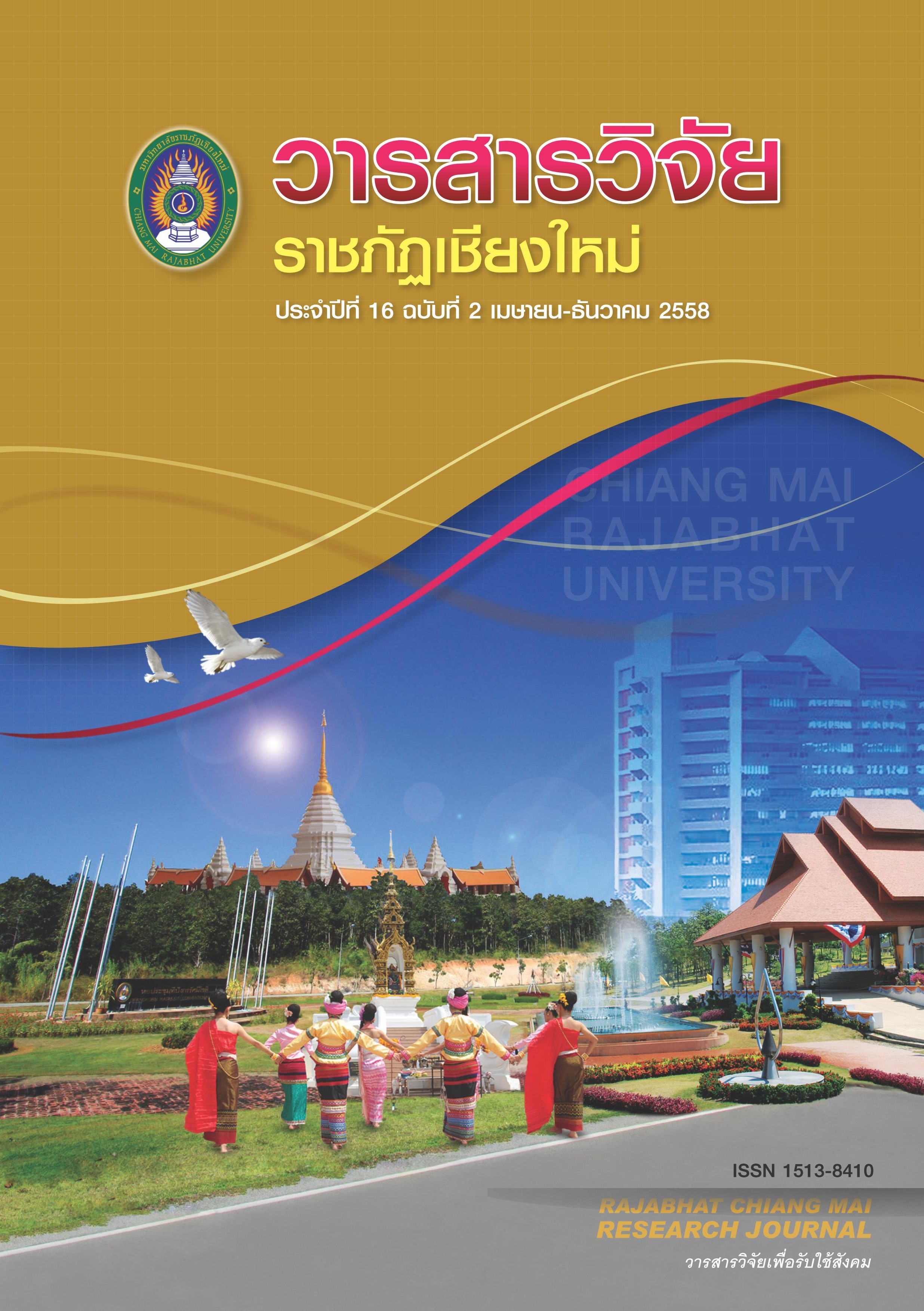การศึกษาลวดลายจกแม่แจ่มเพื่อประยุกต์ใช้ในการถักนิตติ้ง
DOI:
https://doi.org/10.14456/rcmrj.2015.215051คำสำคัญ:
การออกแบบ, การถักนิตติ้ง, ลวดลายผ้าจกแม่แจ่มบทคัดย่อ
การวิจัยเรื่อง การศึกษาลวดลายจกแม่แจ่มเพื่อประยุกต์ใช้ในการถักนิตติ้ง เป็นการวิจัยและพัฒนา โดยมีวัตถุประสงค์เพื่อ 1) ศึกษาลวดลายและเอกลักษณ์ของผ้าจกแม่แจ่ม อำเภอแม่แจ่ม จังหวัดเชียงใหม่ 2) ออกแบบลวดลายผ้าถักนิตติ้งที่ประยุกต์มาจากลวดลายผ้าจกแม่แจ่ม อำเภอ แม่แจ่ม จังหวัดเชียงใหม่ เพื่อสร้างมูลค่าเพิ่มตามแนวคิดเศรษฐกิจสร้างสรรค์ และ 3) ทดสอบแนวคิดผลิตภัณฑ์ผ้าถักนิตติ้งที่ได้พัฒนาขึ้น โดยศึกษาความพึงพอใจของผู้บริโภคกลุ่มเป้าหมาย ประชากรและกลุ่มตัวอย่างที่ใช้ในการวิจัยคือ 1) กลุ่มชาวบ้านไร่ หมู่ที่ 10 ตำบลท่าผา อำเภอแม่แจ่ม จังหวัดเชียงใหม่ โดยเลือกกลุ่มตัวอย่างแบบเจาะจง เฉพาะผู้ที่ให้ข้อมูลเกี่ยวกับลวดลายผ้าจกแม่แจ่ม จำนวน 10 คน 2) กลุ่มตัวแทนชาวบ้านชุมชนบ้านไร่ เพื่อคัดเลือกลวดลายผ้าจกที่นำมาประยุกต์ใช้ในการถักนิตติ้ง จำนวน 5 คน 3) ผู้เชี่ยวชาญในการประเมินลวดลายการถักนิตติ้งและคู่มือการถักนิตติ้ง จำนวน 3 คน 4) กลุ่มเป้าหมายที่ใช้ในการทดลองถักนิตติ้งจากคู่มือการถักนิตติ้ง จำนวน 12 คน 5) กลุ่มผู้บริโภคเป้าหมาย เพื่อทดสอบแนวคิดผลิตภัณฑ์ด้วยการสอบถามความพึงพอใจ จำนวน 100 คน เครื่องมือในการวิจัย ได้แก่ แบบสัมภาษณ์แบบกึ่งมีโครงสร้าง แบบประเมินลวดลายการถักนิตติ้ง คู่มือการถักนิตติ้ง แบบประเมินคู่มือการถักนิตติ้ง และแบบสอบถามความพึงพอใจ วิเคราะห์ข้อมูลโดยหาค่าร้อยละ ค่าเฉลี่ย และส่วนเบี่ยงเบนมาตรฐาน ส่วนข้อมูลเชิงคุณภาพใช้การวิเคราะห์เนื้อหา ผลการศึกษาพบว่า ลวดลายผ้าจกแม่แจ่มแบ่งตามลักษณะลายได้ 4 ลาย ได้แก่ 1) ลวดลายในอุดมคติ 2) ลวดลายคนและสัตว์ 3) ลวดลายพรรณพฤกษา และ 4) ลวดลายเปรียบเทียบสิ่งของใกล้ตัว ลักษณะลายมี 2 รูปแบบ คือ แบบลายโคม และแบบลายกุม โดยเอกลักษณ์ของผ้าทอตีนจกแม่แจ่มมีสีโทนเหลือง สีแดง และสีส้ม ซึ่งลวดลายที่ได้ออกแบบสำหรับนำมาประยุกต์ใช้ในการถักนิตติ้ง ได้แก่ ลายกุดขอเบ็ด ลายเชียงแสนหงส์ปล่อย และลายขันเสี้ยนสำ ซึ่งเป็นรูปแบบลายโคม นำเฉพาะส่วนของลายโคมและลายขันมาทำการออกแบบลวดลาย เพื่อประยุกต์ใช้ในการพัฒนาผลิตภัณฑ์ผ้าพันคอถักนิตติ้ง โดยใช้โปรแกรมคอมพิวเตอร์สำเร็จรูปในการออกแบบ และทำลวดลายผ้าจกบนผ้าถักนิตติ้งด้วยเทคนิคการปักลงบนผ้าตามผังลายที่ได้ออกแบบไว้ เมื่อนำผลิตภัณฑ์ผ้าพันคอถักนิตติ้งให้ผู้เชี่ยวชาญทั้ง 3 ท่าน ประเมินลวดลายการถักนิตติ้ง พบว่า มีค่าคะแนนเฉลี่ยโดยรวม 4.17 และการประเมินคู่มือการถัก นิตติ้งมีคะแนนเฉลี่ยโดยรวม 4.19 ซึ่งอยู่ในระดับมาก เมื่อนำคู่มือไปทดลองใช้กับนักเรียนโรงเรียน สันกำแพง ผลการประเมิน มีค่าคะแนนเฉลี่ยโดยรวม 4.53 อยู่ในระดับมากที่สุด สำหรับการทดสอบแนวคิดผลิตภัณฑ์ด้วยการสอบถามความพึงพอใจ พบว่า ผู้บริโภคกลุ่มเป้าหมายให้คะแนนเฉลี่ยความพึงพอใจต่อผลิตภัณฑ์โดยรวมที่ 4.42 โดยอยู่ในระดับมาก ซึ่งลวดลายที่ผู้บริโภคให้ความพึงพอใจสูงที่สุด ได้แก่ ลายขันเสี้ยนสำ มีค่าคะแนนเฉลี่ย 4.47 ลายเชียงแสนหงส์ปล่อย มีค่าคะแนนเฉลี่ย 4.42 และลายกุดขอเบ็ด มีค่าคะแนนเฉลี่ย 4.38 ตามลำดับ สรุปได้ว่าผลิตภัณฑ์ผ้าพันคอถักนิตติ้งที่ผู้วิจัยได้พัฒนาขึ้น สามารถสร้างมูลค่าเพิ่มตามแนวคิดเศรษฐกิจสร้างสรรค์ได้ ซึ่งเป็นไปตามเกณฑ์ที่กำหนดไว้คือ มีค่าคะแนนเฉลี่ยโดยรวมมากกว่า ระดับ 4.00 และผู้บริโภคให้ข้อเสนอแนะว่า ควรใช้วัสดุในการถักที่หลากหลาย เช่น ไหมพรมเยื่อไผ่ เนื่องจากมีความนุ่ม เมื่อนำมาผลิตเป็นผ้าพันคอจะทำให้ผู้สวมใส่ ไม่เกิดความระคายเคืองต่อผิวหนัง และสามารถสร้างมูลค่าเพิ่มให้กับผลิตภัณฑ์ได้มากกว่า ไหมพรมอะคริลิก
Downloads
เอกสารอ้างอิง
นุสรา เตียงเกตุ. (2545). ลายจกแม่แจ่ม . เชียงใหม่: นพบุรีการพิมพ์.
เบญจรัตน์ จันทร์โต. (2555). การถักผ้าพันคอไหมพรม. [ระบบออนไลน์]. สืบค้นจาก http://productbodin4.blogspot.com/. (19 ตุลาคม 2556).
มณฑา จันทร์เกตุเลี้ยด. (2541). วิทยาศาสตร์สิ่งทอเบื้องต้น. กรุงเทพฯ: ภาควิชาคหกรรมศาสตร์ คณะวิทยาศาสตร์และเทคโนโลยี มหาวิทยาลัยศรีนครินทรวิโรฒ ประสานมิตร.
ระบบสารสนเทศศูนย์อนุรักษ์ผ้าไหม. (มปป). ผ้าจกแม่แจ่ม. [ระบบออนไลน์]. สืบค้นจาก http://www.qsds.go.th/silkcotton/k_21.php. (15 ตุลาคม 2556).
ศจี สุวรรณศรี. (2551). เอกสารประกอบการสอน หลักการพัฒนาผลิตภัณฑ์และการประเมิน คุณภาพทางประสาทสัมผัส. พิษณุโลก: ภาควิชาอุตสาหกรรมเกษตร คณะเกษตรศาสตร์ ทรัพยากรธรรมชาติและสิ่งแวดล้อม มหาวิทยาลัยนเรศวร.
ศรีกาญจนา พลอาสา. (2546). การจัดการสินค้าเสื้อผ้า. กรุงเทพฯ: โรงพิมพ์เดือนตุลา จำกัด.
สหวัฒน์ แน่นหนา. (2556). การเพิ่มมูลค่าให้แก่ทุนทางวัฒนธรรม. (ระบบออนไลน์). สืบค้นจาก : www.finearts.go.th/system/files/cultural.doc. (7 กันยายน 2556).
เฮือนสืบสานผะหญาเมืองแจ่ม. (2555). ตีนจก 16 ลาย. [ระบบออนไลน์]. สืบค้นจาก http://hsp-mj.com/. (15 ตุลาคม 2556).
สำนักคณะกรรมการพัฒนาการเศรษฐกิจและสังคมแห่งชาติ, ศูนย์สร้างสรรค์งานออกแบบ. (2552). รายงานการศึกษาเบื้องต้นเศรษฐกิจสร้างสรรค์. พิมพ์ครั้งที่ 2. กรุงเทพฯ: บี. ซี. เพรส (บุญชิน) จำกัด.
Kulakova, M. (2012). Preserving the Tradition of Patterned Mittens in Latvia. International Federation of Home Economics XXII World Congress. 16 - 21 July 2012. Melbourne Australia.
ดาวน์โหลด
เผยแพร่แล้ว
รูปแบบการอ้างอิง
ฉบับ
ประเภทบทความ
สัญญาอนุญาต
1. บทความ ข้อมูล เนื้อหา รูปภาพ ฯลฯ ที่ได้รับการตีพิมพ์ใน “Community and Social Development Journal” ถือเป็นลิขสิทธิ์ของ Community and Social Development Journal มหาวิทยาลัยราชภัฏเชียงใหม่ และเพื่อให้เผยแพร่บทความได้อย่างเหมาะสมผ่านสื่อสิ่งพิมพ์และอิเล็กทรอนิกส์ ผู้เขียนยังคงถือครองลิขสิทธิ์บทความที่ตีพิมพ์ภายใต้ใบอนุญาต Creative Commons Attribution (CC BY) ซึ่งอนุญาตให้เผยแพร่บทความซ้ำในแหล่งอื่นได้ โดยอ้างอิงต้องอ้งอิงบทความในวารสาร ผู้เขียนต้องรับผิดชอบในการขออนุญาตผลิตซ้ำเนื้อหาที่มีลิขสิทธิ์จากแหล่งอื่น
2. เนื้อหาบทความที่ปรากฏในวารสารเป็นความรับผิดชอบของผู้เขียนบทความโดยตรง ซึ่งกองบรรณาธิการวารสารไม่จำเป็นต้องเห็นด้วยหรือร่วมรับผิดชอบใดๆ














